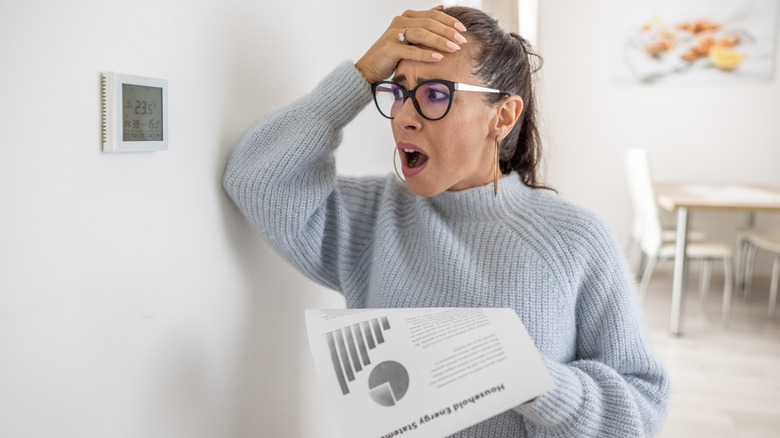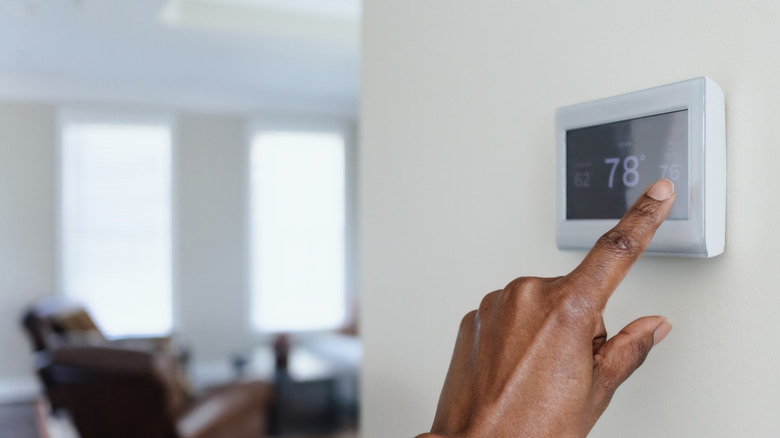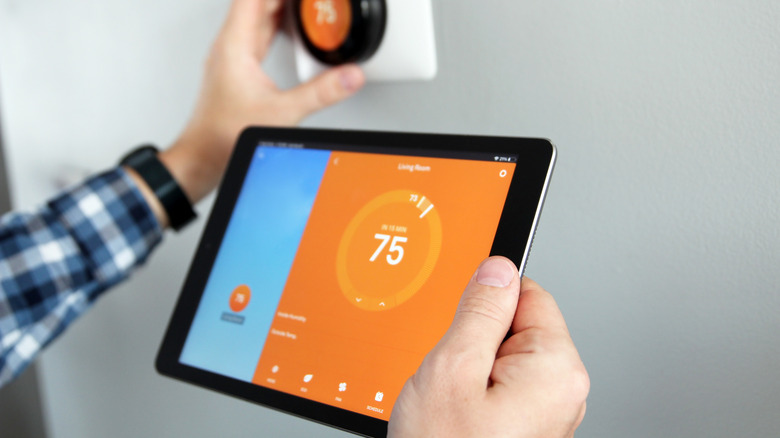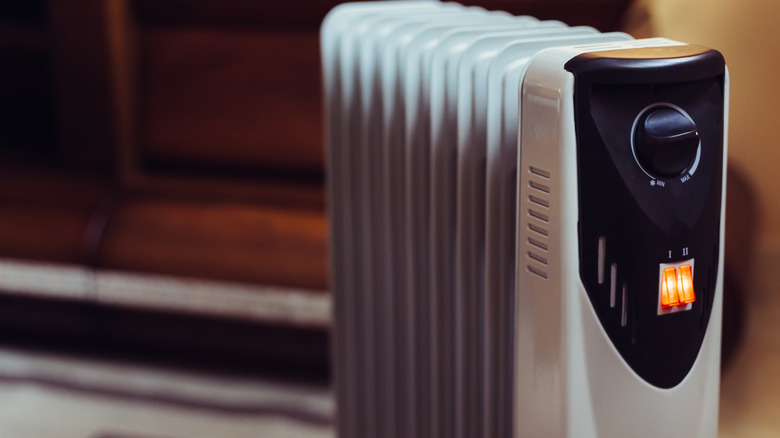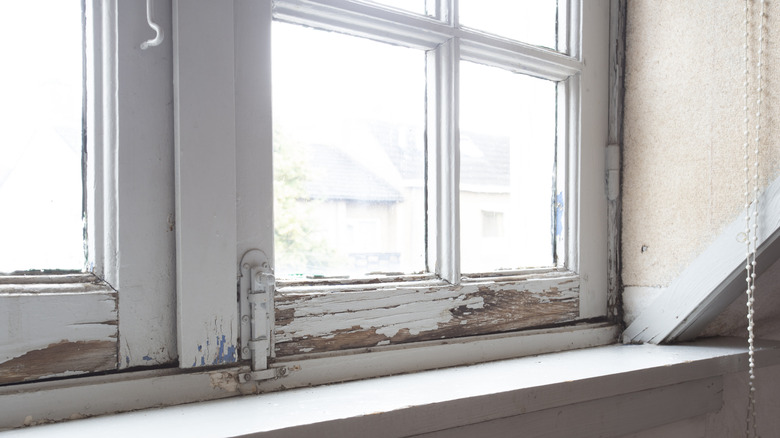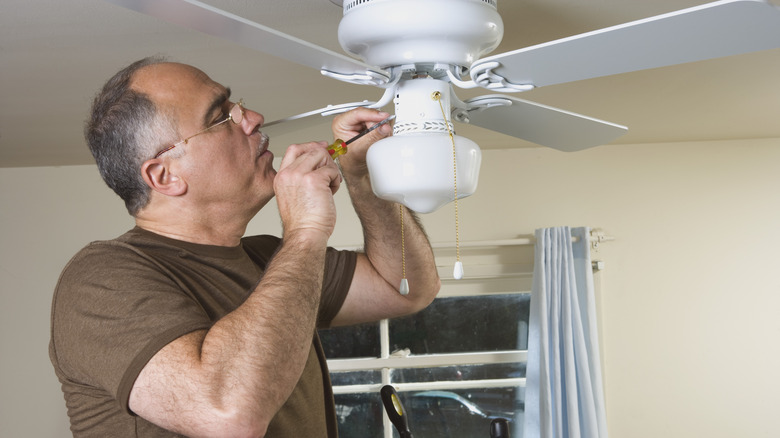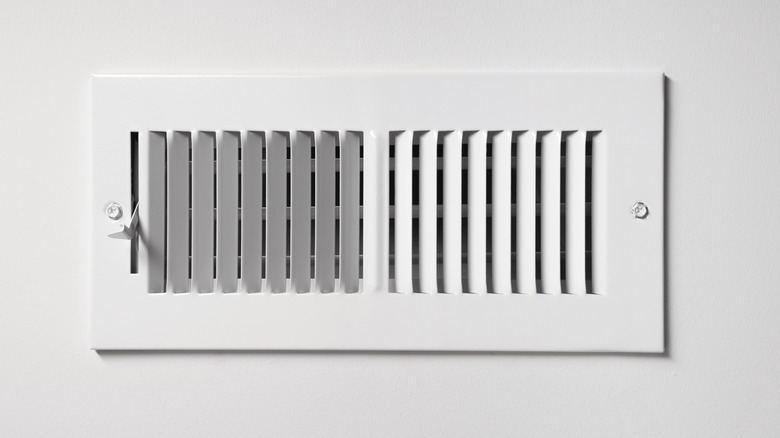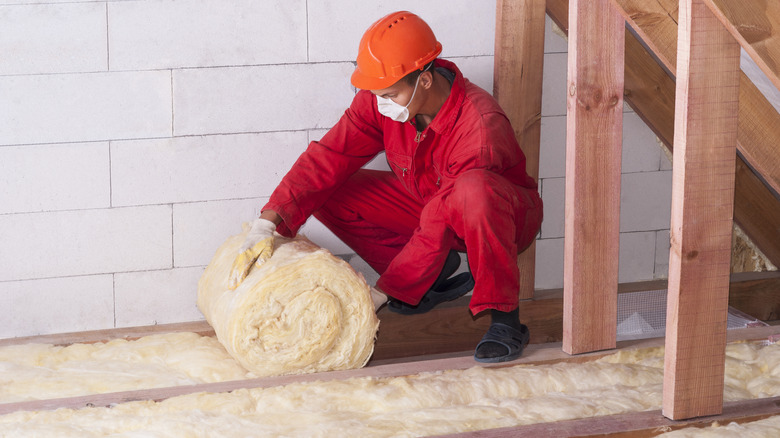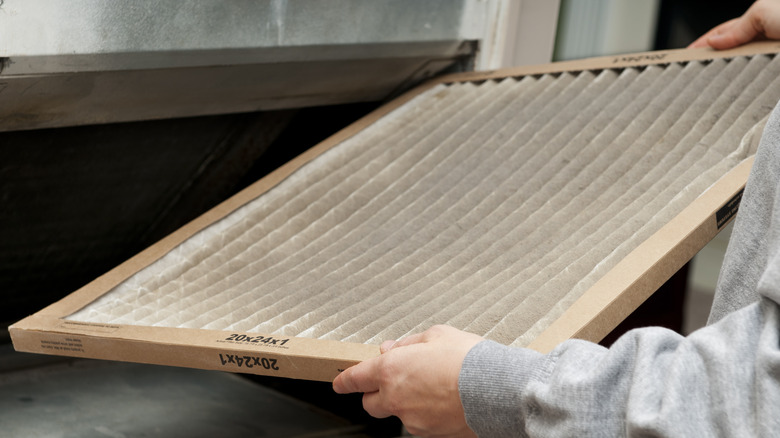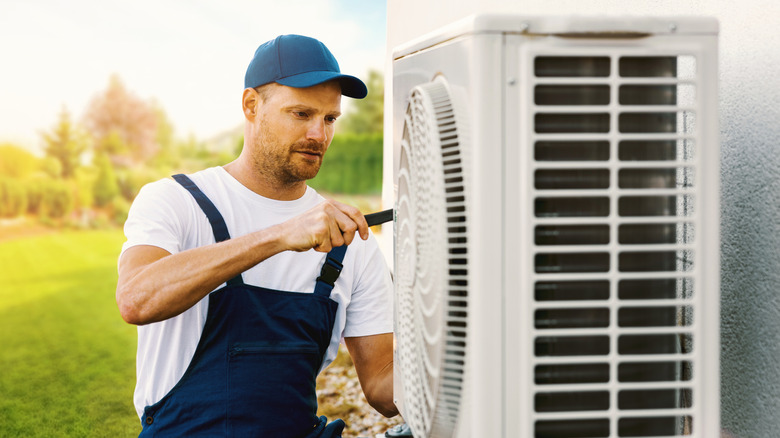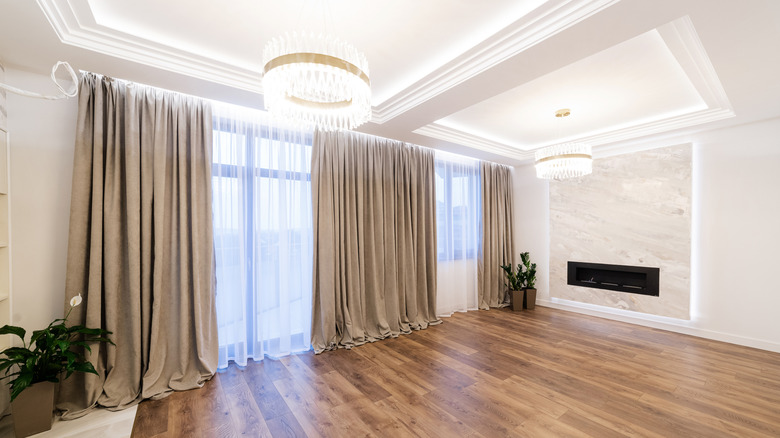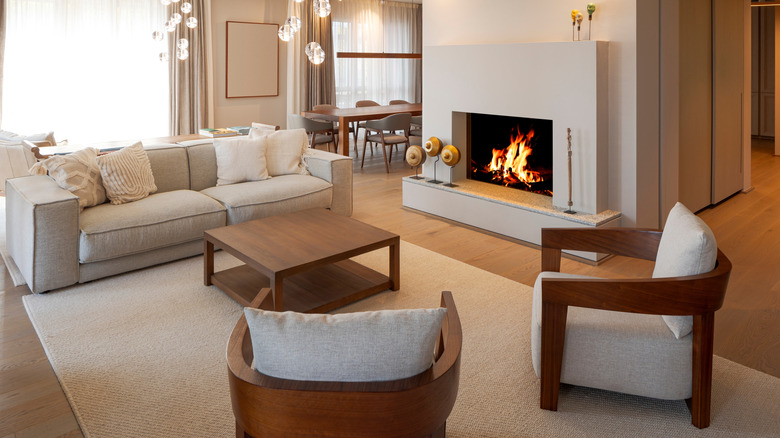Costly Home Heating Mistakes To Avoid This Winter
We may receive a commission on purchases made from links.
Utility costs may be up from previous years. However, those increased rates may not be the only thing to blame if your heating bill is through the roof . Unfortunately, you may be at least partly to blame for these higher bills. There are several heating mistakes that homeowners often make, and some of these mistakes can hit where it hurts the most — your bank account.
If you're tired of opening your heating bill only to feel your jaw drop to the floor, it is time to reevaluate your routine and other decisions that could inadvertently be causing you to pay more than is necessary. While a few of these mistakes may require larger fixes, many of them are actually easy to reverse. A few small investments or quick changes in the way you approach things can have a significant impact. Continue reading to learn more about the most common heating mistakes and what you should be doing to avoid making them.
Not setting your thermostat to the ideal temperature
One of the biggest home heating mistakes you can make is not knowing the ideal indoor temperature to keep costs to a minimum. It can be tempting to crank up the heat on a cold winter day, but the higher you set it, the more you're going to end up shelling out at the end of the month.
Don't worry; you don't have to sacrifice your comfort to keep your bill from exploding. According to the US Department of Energy , 68 to 70 degrees Fahrenheit is the ideal indoor temperature range when you're home. While this may be a few degrees lower than you're used to, it is still warm enough to maintain a comfortable environment. Moreover, setting the temperature to 68 to 70 degrees Fahrenheit can also ensure that your HVAC system is able to operate efficiently. Modern units are designed to work in that moderate range, and cranking the thermostat up will cause the system to work harder to meet those higher temps. This will not only lead to higher energy consumption, but also more wear on your system.
So, just how much money can you save by changing your thermostat settings? Well, the specific amount will depend on where you're currently setting your thermostat, the size of your home, the efficiency of your system, and the utility rates in your area. However, as a general rule, you can expect to save an average of 3% for each degree under 71 degrees Fahrenheit. Those savings can really add up over the course of a few months.
Failing to consider a smart thermostat to keep costs down
If you're looking to reduce your energy costs at home , it would be a mistake to overlook the benefits of installing a smart thermostat . If you're not familiar with smart thermostats, they allow you to control your heating and cooling settings remotely using a cell phone or tablet. Beyond simply being able to adjust the temperature when desired, you can also create schedules for your thermostat to follow. This is where upgrading to a programmable thermostat can really pay off.
When you're not at home, you don't need your HVAC system working so hard to keep your home warm. If you program your thermostat to automatically lower the temperature at the time you leave the house each day, and then warm it back up shortly before you get back home, you'll be using less energy or fuel. Some models are even more advanced, picking up the patterns in your habits and automatically adjusting the temperature to match these patterns. The savings should be noticeable immediately. ENERGY STAR-certified smart thermostats — like the Google Nest Learning Thermostat — save homeowners an average of 8% on their heating (and cooling) bills, according to ENERGY STAR.
Thinking space heaters will save you money
Many people make the false assumption that they can keep their heating costs down by using space heaters instead of raising their thermostats to 68 to 70 degrees. However, this isn't the case. These devices use an average of 1,500 watts of energy. Assuming you were to run just one space heater just during the hours you were home, this would work out to 18 kilowatt-hours (kWh) each day. The average energy cost per kWh is 16.54 cents . So, running the space heater would cost about $20 each week, $83 each month, and $1,000 each year (or even just $330, assuming you only used it for four months out of the year). Remember, this is only for one space heater. If you wanted to use them to heat more than one room in the house, it is easy to see how the costs could end up spiraling out of control.
So, instead of relying on space heaters, let your furnace or HVAC system do the work. If you want to run one for a few hours at a time to heat up a room that doesn't get enough heat pushed into it, you could consider that. But, solely relying on these devices to supplement a lowered thermostat will likely cost much more than you're anticipating.
Failing to address drafty windows and doors
Do you avoid sitting in certain areas of your home because of the cold drafts entering through the windows and doors? These drafts can do more than just make you want to put on a sweater or cuddle up with a fuzzy blanket. They can also cause your heating bill to increase. The extra cold air entering your home forces your HVAC unit to work harder to keep your home at the set temperature. As you probably know, the longer and harder the HVAC unit has to work, the more you'll have to pay to your energy provider. In fact, according to some estimates, drafty windows and doors can account for up to 30 or even 40% of energy loss from your house — that's a lot of extra work that your heating system will need to do to keep your home comfortable.
Instead of leaving these problems unaddressed, there are things you can do to reduce their impact on your bills, even if installing new doors and windows is not in the budget. One easy improvement is to add weather stripping — or replace old and worn out weather stripping — along the base of the door or window. This will help ensure a better seal, blocking that cold air from coming into the house. You could also consider trying a window insulation kit, such as the Duck Max Strength Window Insulation Kit , to reseal drafty windows. These kits come with a plastic film that you use to cover the whole window, sealing off any cracks or gaps. Just note: You will have to remove the film in the spring or summer if you want to be able to open the window to let in fresh air.
Draft stoppers — like the Holikme Weighted Door Draft Stopper — may be a viable solution for the drafty doors in your home. These are designed to be placed right at the base of the door, stopping cold air from getting in from any gap between the floor and the bottom of the door.
Failing to adjust the blade direction for your ceiling fans
Many of us assume our ceiling fans are only there to increase comfort levels in the summer. For this reason, we either leave them off during the winter months or leave their settings completely unchanged. If this describes you, then you've just identified another home heating mistake that you've been making. During the summer months, your ceiling fan's blades should be rotating in a counterclockwise direction. This causes the air to be pushed down, delivering a breeze to keep you cool. However, during the winter months, you should leave your fans rotating clockwise; you don't need the cooling breeze during these months.
Luckily, switching the direction in which the fan blades rotate during the winter is easy. Most fan manufacturers have a switch on the mechanism above the blades to let you change the direction. When they spin clockwise, they help move the warm air around the room. As you probably know, warm air rises. So, when the fan is moving clockwise, an updraft will form to send that air back into the rest of the room instead of leaving it trapped against the ceiling. As a result, your HVAC system won't need to work so hard to maintain the set temperature. This simple change has the potential to save you up to 15% on your heating bills.
Blocking or closing the heating registers for unused rooms in the home
You might want to think twice if you've been closing off vents for unused rooms during the winter. It sounds like this could help you save money, but unfortunately, there is a flaw in this logic. When you close one or more of the registers for your system, it causes it to be less efficient. The air that should be sent to those rooms ends up getting sent into other rooms instead. Excess pressure accumulates in the ducts, which could end up costing you more money.
This puts extra pressure on the air handler to push the air through the remaining open vents, causing it to either overheat and break (in extreme cases), or degrade faster than planned. A new air handler can cost between $1,500 to $3,400 to replace, so it's not something you want to be wearing down. Avoid paying these high costs, and leave your heating registers open. Instead, look for proven ways to lower your heating bill, such as setting the thermostat to 68 degrees Fahrenheit or sealing drafty windows and doors.
Overlooking the benefits of adding some additional insulation to the home
One mistake that could be leaving you with higher-than-necessary heating bills is assuming that your home's insulation is just fine as it is. Unfortunately, many homes simply don't have sufficient insulation to prevent heat from being lost through the walls, floors, and ceilings. If inadequate insulation is allowing air to be lost, it will leave your HVAC unit working double time, trying to produce enough heat to ensure that your home's temperature matches what the thermostat is set at.
Instead of leaving your insulation as is, consider taking some steps to improve it. Contrary to what many may believe, you don't have to rip out all of the walls in the home in order to add more insulation. Instead, it can be added into an existing wall by a professional. They'll drill very small holes and inject a special type of foam insulation. Then, you'll only be left patching the holes and touching up the paint. However, keep in mind that foam insulation can cost two to three times more per square foot than fiberglass, so that initial investment might eat into your savings. However, that initial cost can be offset due to the fact that it also has a higher ROI and offers the best insulation R-value.
However, you'll likely get an even bigger bang for your buck by adding more insulation to your attic. Improving or replacing old insulation in your home's attic improves the overall heating efficiency. The warm air isn't going to be able to continue escaping through the ceilings — or completely out of the home. With more air staying in the house, your system won't need to work as hard to maintain your set temperature. This upgrade has the potential to lower your heating costs by as much as 20%.
Forgetting to change the filter for your HVAC unit
You may assume that the air filter on your HVAC unit only affects the air quality in your home. So, while forgetting to change it won't be ideal for household members with allergies or asthma, it shouldn't affect your heating costs, right? This line of thinking is actually a mistake that could lead to higher heating bills. In addition to lowering the air quality in your home, a dirty HVAC filter can have a negative impact on the efficiency of your unit. If the filter is clogged, the system will need to use more energy in order to move the heated air through it to send it back into the house. The efficiency of your system may be reduced by as much as 15%.
To avoid this, change your air filter regularly. The type of filter you have will impact how frequently it will need to be changed. As a general rule, they should be changed about once every three months. However, it is a good idea to check on them about once per month and replace them if they are looking overly dirty. If anyone in your home has allergies or asthma or you've done any home renovation projects that generated a lot of dust, more frequent replacement may also be necessary to maintain the air quality of your home. If you have a high-efficiency (HEPA) filter, you may be able to go longer between changes. However, it is still advisable to check on these regularly to ensure that they aren't clogged and forcing your HVAC unit to work harder.
Assuming that HVAC maintenance is unnecessary
When you had your HVAC system installed, you were likely told that you should have the unit serviced twice each year. Many people assume that this isn't really that important and that it is just something that heating and cooling companies say to increase their profits. Unfortunately, this isn't the case, and skipping that preventative maintenance could leave you with higher heating bills. Firstly, if your system isn't regularly checked by a professional, a potentially small repair could worsen and turn into one that will be much more costly to fix. Another reason to schedule regular maintenance for your HVAC unit is that it will keep your warranty intact. If the warranty is voided, you may be left paying for a costly replacement sooner than would have otherwise been necessary. In fact, a furnace loses 5% of its energy efficiency rating each time you skip a recommended maintenance call.
To avoid all of these potential problems, schedule HVAC maintenance with a qualified technician twice each year — once towards the beginning of the spring and once towards the beginning of the fall. Scheduling around these times will help ensure your system is ready to make the switch between heating and cooling as the outdoor temperatures change.
Obstructing heating registers with furniture or curtains
If your heating registers are on the floor or towards the bottom of the wall, it can make it challenging to arrange your space without putting a piece of furniture over them. However, even if it requires some careful thought, you shouldn't just place a couch over the registers or hang low curtains that cover them. If they are blocked, it can negatively impact the airflow in your space, potentially reducing it by up to 30%, depending on the location, size, and number of blockages. Reduced airflow can have serious consequences. Excess heat may end up getting stored in the HVAC's heat exchanger. If this continues for prolonged periods of time, it can cause cracks in the exchanger, potentially sending carbon monoxide into the air (and leaving you with a costly replacement if you — hopefully — identify the problem before it is too late).
So, while it can be difficult to work around registers that are on the floor or the base of the wall, doing so is critical. If you want a piece of furniture on a wall where there is a register, pull it forward so that it doesn't cover the exchange. If you want to hang curtains, hem them so that they are at least a few inches off the floor.
Assuming that you'll save money by using the fireplace to heat the home
Assuming that using a fireplace can save you money on your winter heating bills is a common misconception. As is the case with a single space heater, a fireplace cannot heat an entire home. You'll still need to run your HVAC unit for portions of the day. Beyond this general consideration, the cost of operating a fireplace isn't as low as many people assume. As you can probably guess, the specific cost to run a fireplace will depend on the fuel typ e, as well as how many hours you use it for. As a general estimate, gas fireplaces typically cost between $400 and $640 per year with low to moderate usage, wood fireplaces can cost between $400 and over $1,000 per year, and pellet fireplaces may cost between $600 and over $2,000. Electric fireplaces tend to be the least expensive, costing around $100 per year, but they also have a significantly lower heat output and likely won't keep you warm enough on their own.
As you're comparing these operation costs to your heating bills, if you have a wood-burning fireplace, you'll also want to consider how much heat will escape. As much as 90% of the heat these fireplaces create leaves the house through the chimney. You'll also have to open the flue after the fire is out, which will cause even more of the heat from your home to escape.
